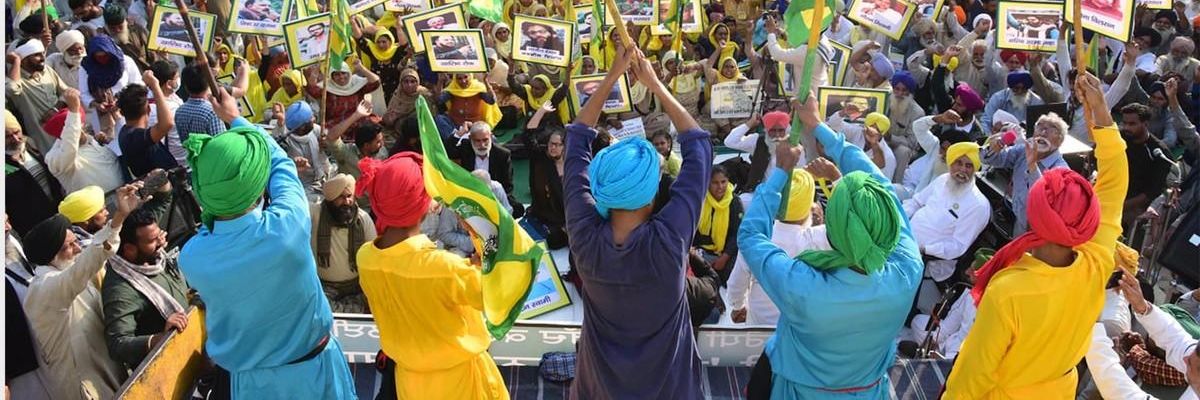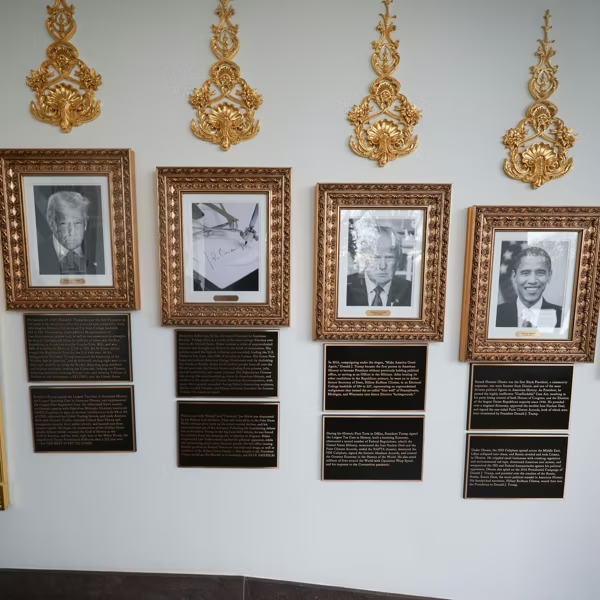
Indian farmers protest near New Delhi on December 11, 2020. (Photo: Randeep Maddoke/Wikimedia Commons)
Building the Global Movement
By centering the movement-building process—we transcend the historical failures of elite constitutional design and build the strategic capacity to mobilize the necessary resources in sufficient time to reconstruct our global political economy, avoiding the worst possible climate futures.
Does the process of constitution-making matter more than the particularities of constitutional design? Recently published research by a growing range of social scientists and legal scholars indicates yes. For instance, in their book Constituents Before Assembly, Todd Eisenstadt, A. Carl LeVan, and Tofigh Maboudi provide their findings from a sweeping empirical analysis of the effects of popular participation in constitutionalization. The takeaway? As noted in my Law & Society Review review, "participatory constitution-making...has a lasting and systematic effect on subsequent democratization."
Regardless of the particular terrains on which global constitutionalization moves forward, it is the deliberative mobilization of millions of peoples that ultimately is vital to success.
My own doctoral research built on the works of Maboudi and his colleagues, as well as sundry others, and asked about the role of democracy movements in making constitutions. A comparative analysis of the eleven top-30 GDP countries that underwent formal constitutionalization processes between 1974 and 2001 showed that the strategies of democracy movements in relation to constitutional openings were significantly determinative of subsequent democratization. In cases where such movements engaged in a revolutionary constitutional practice (mass engagement in deliberative constitutionalism from below, producing clearly articulated constitutional programs as in Brazil, Canada, Poland, South Africa, and Spain), both textual and substantive democratization followed. In cases where democracy movements failed to practice revolutionary constitutionalism (Australia, China, Iran, Russia, Saudi Arabia, Turkey), the outcomes ranged from middling to disastrous.
Of course, these stories are complex. But the argument involves, in part, the ideas expressed in this excerpt:
"A social movement can be defined as a collective application of human energies through the medium of society for the purpose of agitating and reconfiguring social relations toward common goals. Thus, a social movement is a wave. There is significant variation among different movement forms in their scope and intensity. When constitutional movements arise, they assemble broad coalitions out of diverse sectors of society. As a result, if successful, their effects extend far beyond formal law."
What does this mean for the idea of an Earth Constitution? Among other things, it suggests that approaches to global constitutional change that center the state, government, governance, nations, and existing global institutions are misguided. Yes, we should consider plural approaches to constitutional change. And the structures through which movements move matter; they condition possibilities. But regardless of the particular terrains on which global constitutionalization moves forward, it is the deliberative mobilization of millions of peoples that ultimately is vital to success.
By centering the movement-building process--in this case, the question of how a global constitutional movement builds itself through plural yet concerted democratic engagements--we transcend the historical failures of elite constitutional design and build the strategic capacity to mobilize the necessary resources in sufficient time to reconstruct our global political economy, avoiding the worst possible climate futures. The emerging technological revolutions of this period make possible decentralized coordination on a global scale. The prefigurative constitutionalisms of earlier efforts such as the Constitution for the Federation of Earth as well as the more recent Encuentros, Cochabamba, Occupy, Movement for Black Lives, solidarity economy, climate strike, and Social Forum processes, among others, make a global constitutional transition from below that much more likely.
The question that matters most is not whether an Earth Constitution is a good or necessary idea. It is also not what we, ourselves, believe the design of such a constitution should be. The question we must take up is that of how to engage hundreds of millions of our fellow human beings in a mass constitution-making process from below.
This article was originally published on the Great Transition Initiative as part of the Forum "An Earth Constitution: Has Its Time Come?"
An Urgent Message From Our Co-Founder
Dear Common Dreams reader, The U.S. is on a fast track to authoritarianism like nothing I've ever seen. Meanwhile, corporate news outlets are utterly capitulating to Trump, twisting their coverage to avoid drawing his ire while lining up to stuff cash in his pockets. That's why I believe that Common Dreams is doing the best and most consequential reporting that we've ever done. Our small but mighty team is a progressive reporting powerhouse, covering the news every day that the corporate media never will. Our mission has always been simple: To inform. To inspire. And to ignite change for the common good. Now here's the key piece that I want all our readers to understand: None of this would be possible without your financial support. That's not just some fundraising cliche. It's the absolute and literal truth. We don't accept corporate advertising and never will. We don't have a paywall because we don't think people should be blocked from critical news based on their ability to pay. Everything we do is funded by the donations of readers like you. Will you donate now to help power the nonprofit, independent reporting of Common Dreams? Thank you for being a vital member of our community. Together, we can keep independent journalism alive when it’s needed most. - Craig Brown, Co-founder |
Does the process of constitution-making matter more than the particularities of constitutional design? Recently published research by a growing range of social scientists and legal scholars indicates yes. For instance, in their book Constituents Before Assembly, Todd Eisenstadt, A. Carl LeVan, and Tofigh Maboudi provide their findings from a sweeping empirical analysis of the effects of popular participation in constitutionalization. The takeaway? As noted in my Law & Society Review review, "participatory constitution-making...has a lasting and systematic effect on subsequent democratization."
Regardless of the particular terrains on which global constitutionalization moves forward, it is the deliberative mobilization of millions of peoples that ultimately is vital to success.
My own doctoral research built on the works of Maboudi and his colleagues, as well as sundry others, and asked about the role of democracy movements in making constitutions. A comparative analysis of the eleven top-30 GDP countries that underwent formal constitutionalization processes between 1974 and 2001 showed that the strategies of democracy movements in relation to constitutional openings were significantly determinative of subsequent democratization. In cases where such movements engaged in a revolutionary constitutional practice (mass engagement in deliberative constitutionalism from below, producing clearly articulated constitutional programs as in Brazil, Canada, Poland, South Africa, and Spain), both textual and substantive democratization followed. In cases where democracy movements failed to practice revolutionary constitutionalism (Australia, China, Iran, Russia, Saudi Arabia, Turkey), the outcomes ranged from middling to disastrous.
Of course, these stories are complex. But the argument involves, in part, the ideas expressed in this excerpt:
"A social movement can be defined as a collective application of human energies through the medium of society for the purpose of agitating and reconfiguring social relations toward common goals. Thus, a social movement is a wave. There is significant variation among different movement forms in their scope and intensity. When constitutional movements arise, they assemble broad coalitions out of diverse sectors of society. As a result, if successful, their effects extend far beyond formal law."
What does this mean for the idea of an Earth Constitution? Among other things, it suggests that approaches to global constitutional change that center the state, government, governance, nations, and existing global institutions are misguided. Yes, we should consider plural approaches to constitutional change. And the structures through which movements move matter; they condition possibilities. But regardless of the particular terrains on which global constitutionalization moves forward, it is the deliberative mobilization of millions of peoples that ultimately is vital to success.
By centering the movement-building process--in this case, the question of how a global constitutional movement builds itself through plural yet concerted democratic engagements--we transcend the historical failures of elite constitutional design and build the strategic capacity to mobilize the necessary resources in sufficient time to reconstruct our global political economy, avoiding the worst possible climate futures. The emerging technological revolutions of this period make possible decentralized coordination on a global scale. The prefigurative constitutionalisms of earlier efforts such as the Constitution for the Federation of Earth as well as the more recent Encuentros, Cochabamba, Occupy, Movement for Black Lives, solidarity economy, climate strike, and Social Forum processes, among others, make a global constitutional transition from below that much more likely.
The question that matters most is not whether an Earth Constitution is a good or necessary idea. It is also not what we, ourselves, believe the design of such a constitution should be. The question we must take up is that of how to engage hundreds of millions of our fellow human beings in a mass constitution-making process from below.
This article was originally published on the Great Transition Initiative as part of the Forum "An Earth Constitution: Has Its Time Come?"
Does the process of constitution-making matter more than the particularities of constitutional design? Recently published research by a growing range of social scientists and legal scholars indicates yes. For instance, in their book Constituents Before Assembly, Todd Eisenstadt, A. Carl LeVan, and Tofigh Maboudi provide their findings from a sweeping empirical analysis of the effects of popular participation in constitutionalization. The takeaway? As noted in my Law & Society Review review, "participatory constitution-making...has a lasting and systematic effect on subsequent democratization."
Regardless of the particular terrains on which global constitutionalization moves forward, it is the deliberative mobilization of millions of peoples that ultimately is vital to success.
My own doctoral research built on the works of Maboudi and his colleagues, as well as sundry others, and asked about the role of democracy movements in making constitutions. A comparative analysis of the eleven top-30 GDP countries that underwent formal constitutionalization processes between 1974 and 2001 showed that the strategies of democracy movements in relation to constitutional openings were significantly determinative of subsequent democratization. In cases where such movements engaged in a revolutionary constitutional practice (mass engagement in deliberative constitutionalism from below, producing clearly articulated constitutional programs as in Brazil, Canada, Poland, South Africa, and Spain), both textual and substantive democratization followed. In cases where democracy movements failed to practice revolutionary constitutionalism (Australia, China, Iran, Russia, Saudi Arabia, Turkey), the outcomes ranged from middling to disastrous.
Of course, these stories are complex. But the argument involves, in part, the ideas expressed in this excerpt:
"A social movement can be defined as a collective application of human energies through the medium of society for the purpose of agitating and reconfiguring social relations toward common goals. Thus, a social movement is a wave. There is significant variation among different movement forms in their scope and intensity. When constitutional movements arise, they assemble broad coalitions out of diverse sectors of society. As a result, if successful, their effects extend far beyond formal law."
What does this mean for the idea of an Earth Constitution? Among other things, it suggests that approaches to global constitutional change that center the state, government, governance, nations, and existing global institutions are misguided. Yes, we should consider plural approaches to constitutional change. And the structures through which movements move matter; they condition possibilities. But regardless of the particular terrains on which global constitutionalization moves forward, it is the deliberative mobilization of millions of peoples that ultimately is vital to success.
By centering the movement-building process--in this case, the question of how a global constitutional movement builds itself through plural yet concerted democratic engagements--we transcend the historical failures of elite constitutional design and build the strategic capacity to mobilize the necessary resources in sufficient time to reconstruct our global political economy, avoiding the worst possible climate futures. The emerging technological revolutions of this period make possible decentralized coordination on a global scale. The prefigurative constitutionalisms of earlier efforts such as the Constitution for the Federation of Earth as well as the more recent Encuentros, Cochabamba, Occupy, Movement for Black Lives, solidarity economy, climate strike, and Social Forum processes, among others, make a global constitutional transition from below that much more likely.
The question that matters most is not whether an Earth Constitution is a good or necessary idea. It is also not what we, ourselves, believe the design of such a constitution should be. The question we must take up is that of how to engage hundreds of millions of our fellow human beings in a mass constitution-making process from below.
This article was originally published on the Great Transition Initiative as part of the Forum "An Earth Constitution: Has Its Time Come?"

